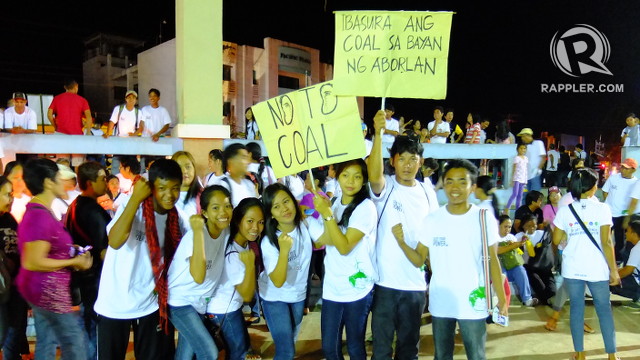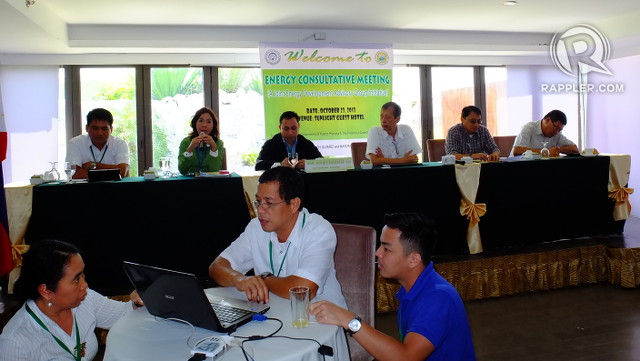SUMMARY
This is AI generated summarization, which may have errors. For context, always refer to the full article.
PUERTO PRINCESA, Palawan – The coal plant to be built in the town of Aborlan in Palawan may be converted into a renewable energy plant in a few years’ time, said its developer DMCI Power Corporation.
“DMCI is very open to the idea of converting the coal plant into a biomass plant. At first, it can be 70% coal and 30% biomass. Actually, DMCI is studying renewable energy,” DMCI Power Corporation vice president Henry Alcalde told Rappler.
DMCI representatives participated in the first consultative session for Palawan’s energy master plan held on October 23 in this city.
The proposed coal plant aims to address the wide gaps in Palawan’s power supply that has led to almost daily brownouts in the province. Caesar Ventura, who advises the provincial government on energy matters, called it an interim measure until more investors and funding come in to help Palawan achieve its goal of a 100% renewable energy future.
The coal plant, however, faces fierce opposition from locals who fear its negative impacts on public health and the environment. Residents from the town of Narra, the plant’s first proposed location, successfully stopped its construction saying it could endanger the population of critically-endangered Philippine cockatoo that forage in the area.
Environmentalists also worry that the construction of the coal plant could endanger Palawan’s UNESCO citation as a Man and Biosphere Reserve, a distinction given to places in the world with sound green practices and well-preserved ecosystems.
Others see the coal plant as a step in the wrong direction for Palawan’s renewable energy plans. But Alcalde said the issue is not in black and white. A compromise could offer Palawan the best of both worlds.
The retrofitting of coal plants into natural gas-fired plants is gaining ground in many countries all over the world, notably in the United States. Industry analysts project that by 2015, 15% of all coal plants in the US will convert to natural gas.
This retrofitting is possible because the equipment of most coal plants can also combust biomass into natural gas. Biomass is organic material, usually plants, that store the sun’s energy. A combustion process allows the stored solar energy to be converted into electricity.
Ventura said the coal plant’s conversion into a biomass plant is one of two conditions he wants met before DMCI can begin construction.
“They should give us the commitment that they will only stay here 3 or 4 years. Then they will convert to biomass. We can use their plant. Secondly, they should show that their facilities won’t lead to environmental or health hazards,” he told Rappler.
Boon or bane?
The coal plant is set to generate 15 megawatts of energy, enough to power 15 to 18 towns, said Alcalde.
If the construction of the coal plant in Narra was approved, the plant would’ve already started generating energy this December. DMCI Power Corporation is now looking at 3 possible locations for the plant. It will take 16 months from the start of construction until it can provide much-needed energy for Palaweños.
Aborlan, one of the towns being considered, has submitted their endorsement for the plant to be built in their community. This despite a march last September in which 1,500 Aborlan locals protested the construction of the plant.
Alcalde is unfazed by the resistance. “There is always opposition. Even bridges and roads are opposed even if they pose many benefits to the community.”
Communities have much to gain from the coal plant, he said.
For one, it uses a new eco-friendly and more efficient technology. The coal plant’s circulating fluidized bed furnace (CFB) technology lowers the amount of air pollution produced by conventional coal plants.
It does this by lowering the temperature during the combustion process. The lower the temperature, the less nitrogen oxides or NOx produced and released into the atmosphere as air pollution.
DMCI also promises to lower electricity costs for Palaweños. Energy from the coal plant will cost only P9.35 per kilowatt/hour, a significant decrease from the current P12 rate.
Mere ‘rhetoric’
But Grizelda Mayo Anda, a lawyer who is a member of Palawan Alliance for Clean Energy (PACE), is not convinced.
“Look at the Iloilo coal plant. The locals were promised that the price would go to P6 but it stayed at P8 and it’s going up. It’s just promises,” she warned.
And the price announced by DMCI is bound to increase due to value added tax whereas renewable energy is not subjected to VAT as stated in the Renewable Energy Law of 2008, she added.
Though DMCI claims it continues to keep the public well-informed, Anda said the company has yet to release an Environmental Impact Assessment (EIA) that should provide important information about the project, like site location and social and environmental impacts.
Consultations conducted by DMCI among local stakeholders do not show the complete picture of the issue. “The consultations are looking at the positive side of coal, not the impacts. There is no discussion about carbon dioxide emissions, greenhouse gas emissions or the bottom ash,” the lawyer said.
Coal plants produce two types of ash: fly ash and bottom ash. Fly ash is the non-combustible material that escapes up the coal plant’s chimneys. Bottom ash is the ash that sticks to the walls of the furnace during the combustion of coal.
While DMCI showed how the coal plant’s machines can capture the fly ash, they did not address how the bottom ash will be stored or dumped.
With Aborlan’s blessing, DMCI now needs only an Environmental Compliance Certificate (ECC) from the Department of Environment and Natural Resources (DENR) to begin construction. Ventura said the ECC is the company’s priority at the moment. To obtain the ECC, DMCI must submit their EIA and secure a Strategic Environmental Planning (SEP) clearance from the Palawan Council for Sustainable Development.
Is the coal plant as good as built?
“Who will stop us if we follow all the laws?” said Alcalde confidently.
But those who don’t want the coal plant aren’t about to give up.
“The communities have already submitted petitions. Right now, there are around 5,000 people who have signed. These have to be brought to the attention of the municipal and provincial government and the PCSD,” said Anda.
“We have written to government that until and unless DMCI shows the public their EIA, we will opt for more petitions or even legal action. But we’re not giving up hope that through dialogues and petitions, government will listen,” she said.
As for DMCI’s willingness to convert to renewable energy, Anda cautions once more against promises and “mere rhetoric.”
“That’s why we need to see the Environmental Impact Assessment. You cannot just agree based on a mere promise.” – Rappler.com
Add a comment
How does this make you feel?



There are no comments yet. Add your comment to start the conversation.